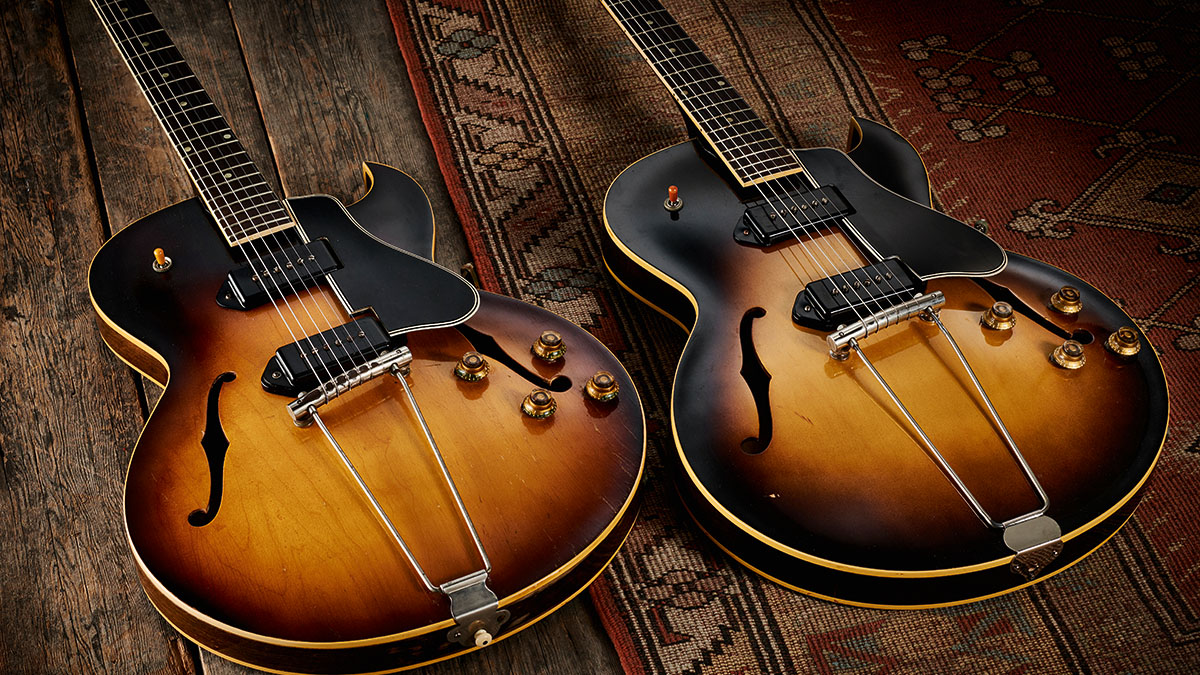
The ES-225 is to a pre-1956 Les Paul Goldtop what a ES-335 is to a ’Burst. If you compare an ES-225 from 1956 with any pre-1956 Goldtop, you’ll notice identical pickups, potentiometers, tone capacitors, control knobs and switches. Assuming the guitar in question is original, even the truss rod cover and nylon nut are the same.
ES-225 neck profiles and frets evolved throughout the 1950s, and they tracked the Les Paul models very closely. Besides the buttons, the Kluson tuners are identical, too, so that leaves the thinline body as the only significant point of difference. Even the trapeze bridge is a throwback to the earliest Les Pauls and it actually enhances the ES-225 – but more on that later.
The skinny
During the ’50s, players were beginning to appreciate smaller and more comfortable guitars with extra feedback resistance, and Gibson was facing stiff competition. In those days, Gibson was a fairly traditional guitar manufacturer, and it hit on an idea that maintained the company aesthetic while catering to the latest trends: it introduced new models with thinner bodies.
In essence, the ES-225 is a thinner version of the ES-295, which is just an ES-175 with a fancy tailpiece and glitzy lacquer. All three models share an identical Florentine cutaway outline and laminated body construction, but where the ES-295 and ES-175 measure 3 5/16 inches (84mm) deep at the rims, the ES-225s clock in at just 1 11/16 inches (43mm).
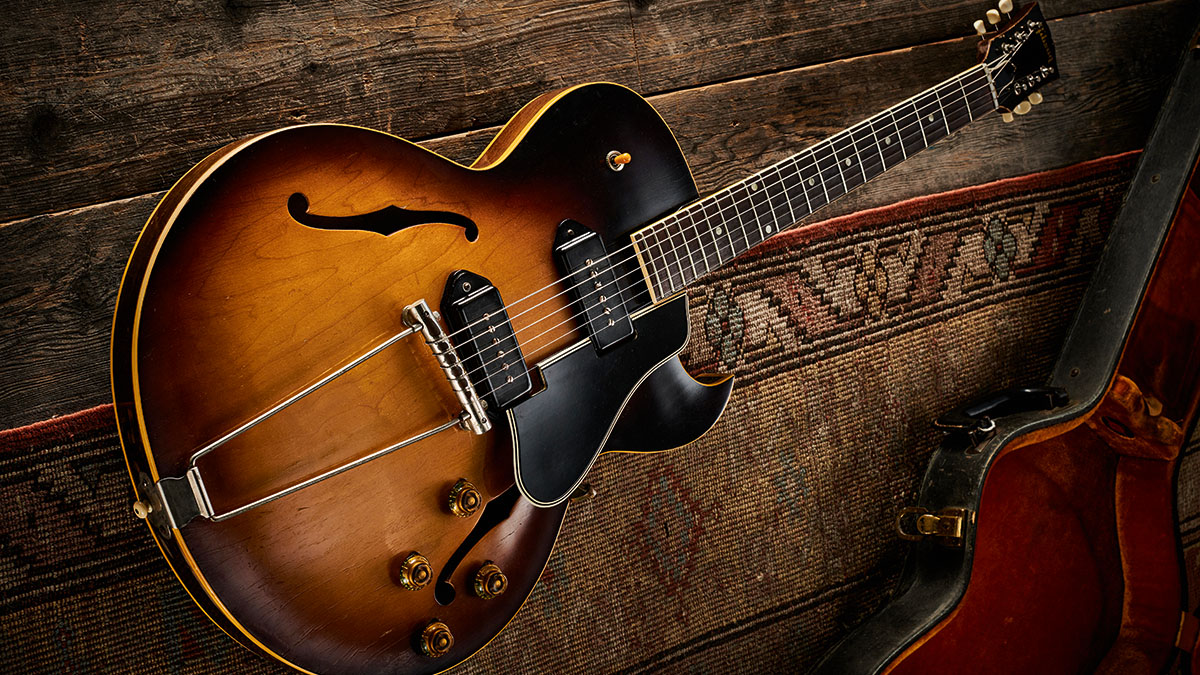
The ES-225 was Gibson’s first thinline electric and, as such, the forerunner of the ES-330 and ES-335 and many others. The ES-225 was soon joined by the ES-350T and carved top Byrdland, but it was the only one with Gibson’s full 24 ¾ -inch scale length.
The other two had a 23 ½-inch scale length and were actually a half-inch thicker. But the ES-225 has a hidden feature that sets it apart from all the others and can be seen as a significant first step towards the radical centre-block design of the ES-335.
Gibson glued a maple block measuring about half an inch thick between the top braces. It extends from the bridge area towards the lower bout and it must be assumed that Gibson did so to solidify the top and dampen resonance.
Get The Pick Newsletter
All the latest guitar news, interviews, lessons, reviews, deals and more, direct to your inbox!
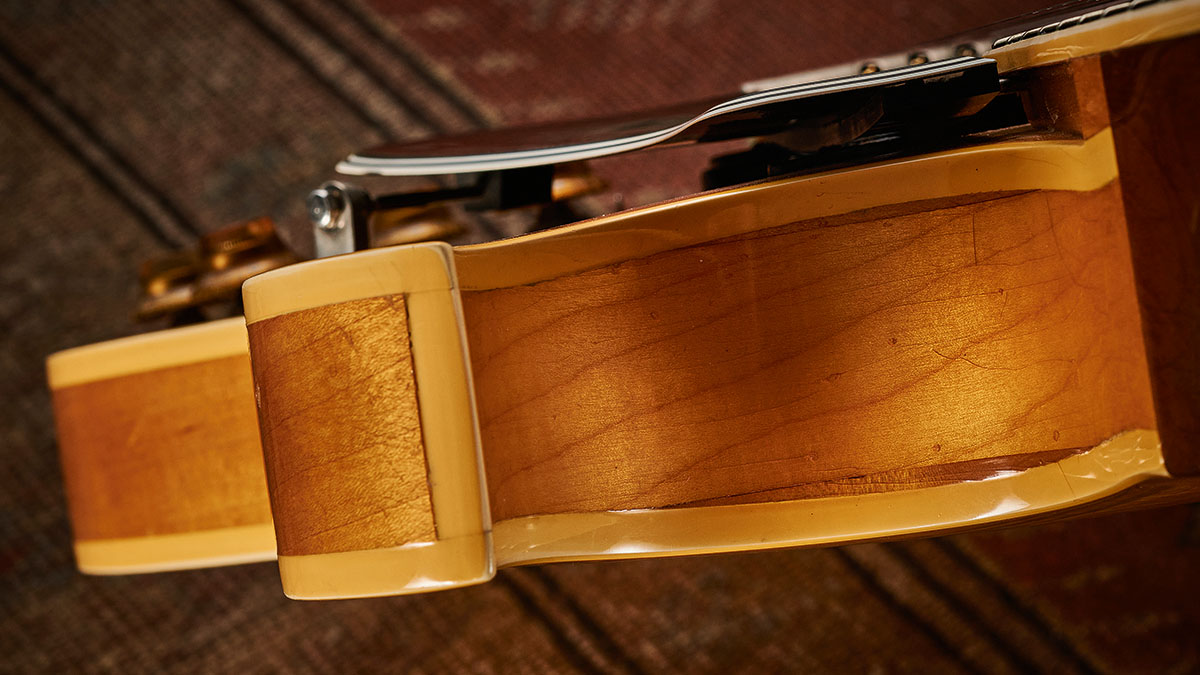
One or two
The ES-225T was introduced in 1955 as a single-pickup guitar. This wasn’t uncommon for archtop guitars, but rather than situate the pickup in the usual neck position, Gibson elected to place it dead centre instead. Being charitable, it could be argued that single-pickup ES-225s offer a distinct and engaging tone.
Conversely, you may find the middle pickup simply gets in the way of your picking hand and the tonal limitations make the ES-225T models precisely one third as good as the dual-pickup ES-225TD models that followed in 1956.
That bridge
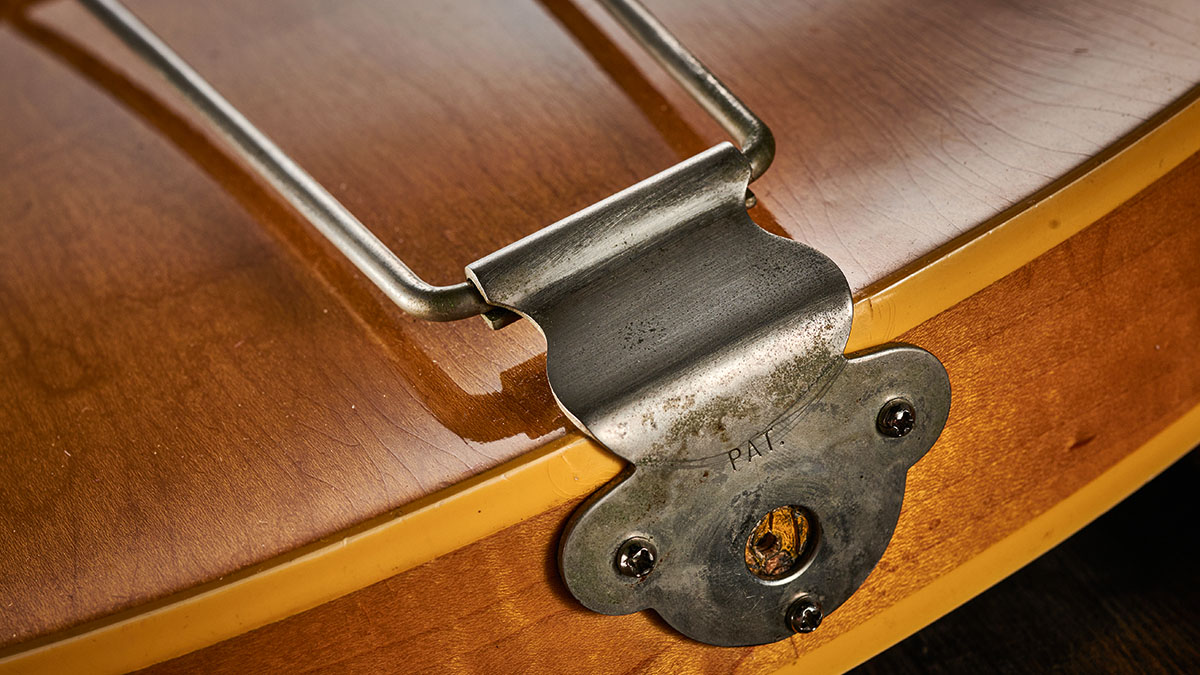
The ES-225’s trapeze tailpiece/bridge unit is an elongated version of the bridge that was fitted to Les Paul Goldtops in 1952 and early 1953. As such, their reputation is tainted by association, but there is absolutely nothing wrong with the bridge itself when it’s used as intended by its designer, Lester William Polsfuss.
The shallow neck angle on the earliest Goldtops meant that the strings had to be wrapped under the bridge, and this renders them uncomfortable to play and tricky to palm-mute. But on an ES-225 the bridge is top-wrapped, so it produces great tone and there’s sufficient downwards pressure to prevent the bridge from sliding about.
Having tried both bridges on the same ES-225, we can report that the original bridge sounds louder and fuller, and has greater sustain
The trapeze bridge lasted until the ES-225’s final year of production in 1959, when Gibson changed to an ES-330-style trapeze with a ABR-1 Tune-O-Matic bridge mounted on a floating rosewood base. Having tried both bridges on the same ES-225, we can report that the original bridge sounds louder and fuller, and has greater sustain.
Les Paul registered his ‘Combined Bridge And Tail Piece For Stringed Instruments’ in 1952 and was awarded the patent number 2737842 in 1956. Gibson had water slide patent number decals made up and attached them to the underside of the trapeze hinge plate, right next to the ground wire solder joint. They must have over-ordered because these decals were later used to replace the ‘patent applied for’ decals on early 1960s humbuckers.
In use
We must confess to always blithely assuming that ES-225s must be a more archaic version of the ES-330. After eventually trying one – a 1958 ES-225 TDN – it turned out to be nothing of the sort. Having owned and endured a mixed relationship with three ES-330s, we were surprised to find that ES-225s display a more even response all along the fretboard, noticeably longer sustain and a good balance between the pickups.
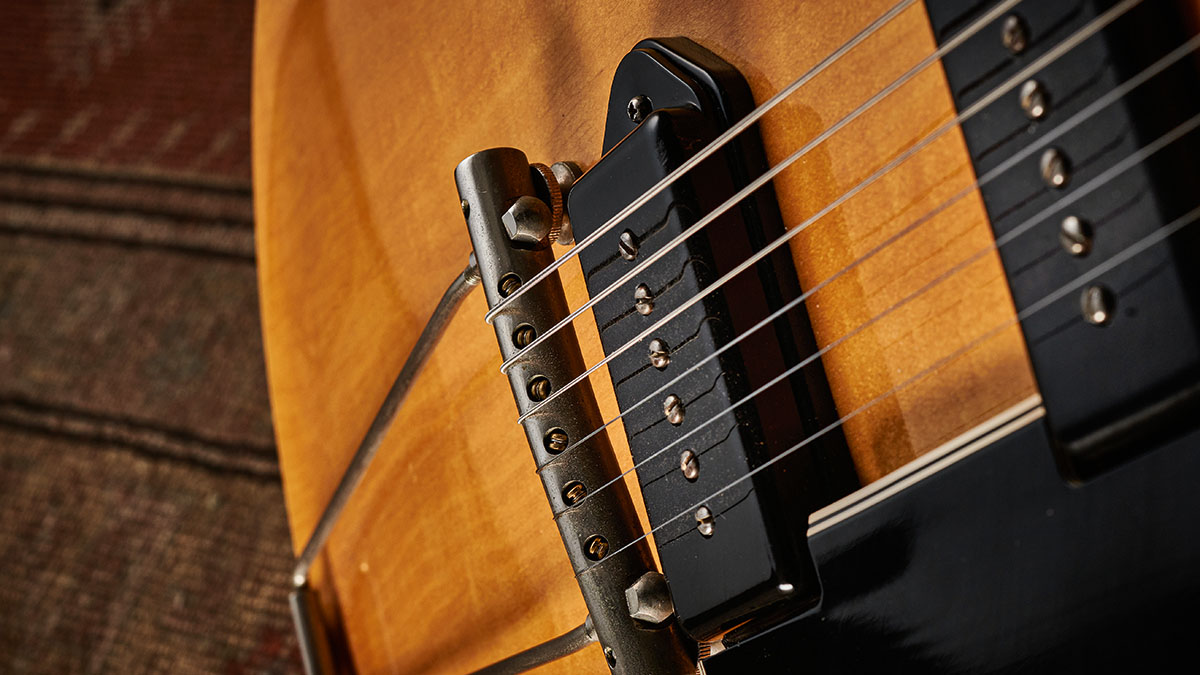
Hardcore ES-330 fans may miss the livelier acoustic response, but the ES-225 is somewhat more predictable and easier to handle at higher volume levels. While not entirely like an ES-335 in the semi-solid stakes, the evidence suggests that the maple block under the bridge does exert an influence. As a result, we believe that the ES-225 is, in fact, more versatile than an ES-330.
In clean mode it’s more than capable of producing mellow and woody jazz sounds on the neck pickup, and then you can flick to the middle setting to indulge in some Chet Atkins-style picking. Add some slapback echo to that factory shimmed bridge pickup, and you’ll be able to enjoy a range of classic rock ’n’ roll and rockabilly tones.
Dial in some dirt and ES-225s ease effortlessly into blues and rock territory. Powerchords sound immense and lead lines have the fluid and vocal quality that exemplifies 1950s Gibsons. Granted, they’re not really built for shredders, but there’s enough sustain and solidity to veer towards classic rock and fusion. Fans of George Thorogood’s ES-125 slide tones may be interested to hear that ES-225s can sound much the same.
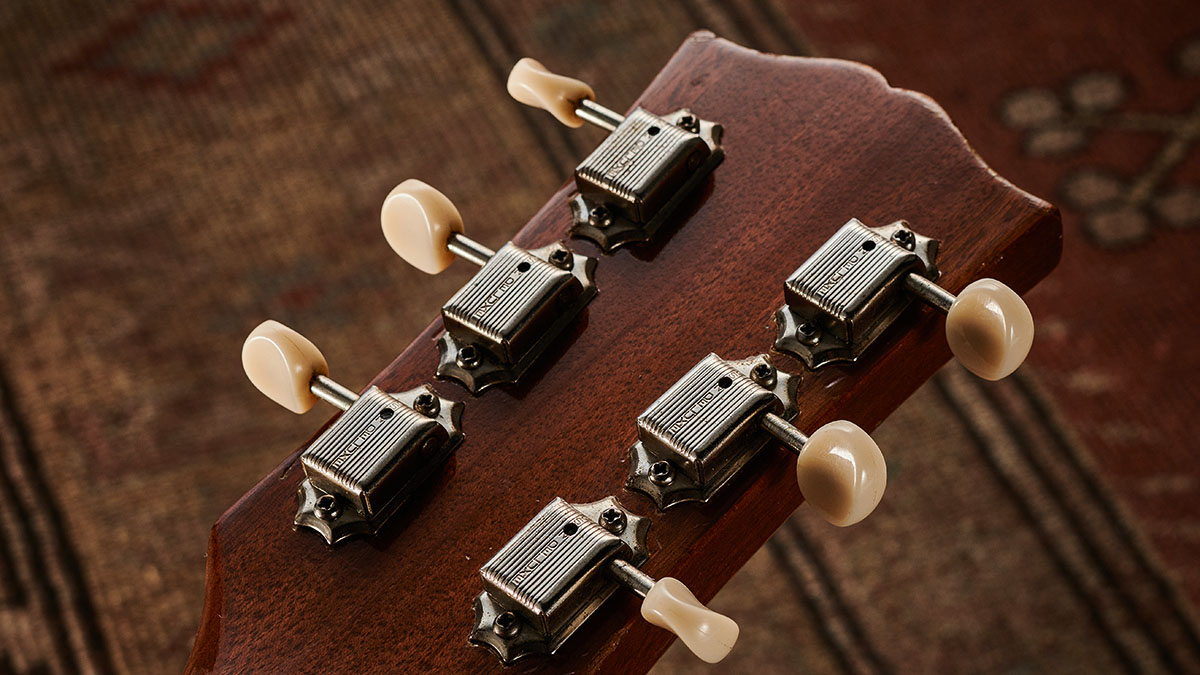
It should be noted, however, that ES-225s do vary to some extent. First and foremost, P-90s underwent changes through the 1950s, and there was some variation in the magnets Gibson used. Earlier examples will probably have Alnico III magnets, which have a softer and woodier character than the Alnico II, IV and V magnets in later 1950s P-90s.
In addition to the sublime late-50s neck profile, you can also expect later ES-225s to have P-90s with slightly more treble and higher output. The frets changed, too, and although the effect on tone is minimal, many players will find the fatter frets, which Gibson installed from 1958 onwards, more comfortable than the skinny frets on 1955 to 1957 examples.
Mods and buying tips
If you have a 1959 ES-225 with an ABR-1 and the later tailpiece, you should probably keep the guitar original – or maybe replace that trapeze with a Bigsby. On the other hand, an earlier model with a replaced bridge would certainly benefit from having an original trapeze reinstalled.
They do come up for sale fairly regularly and any money you spend will increase your guitar’s value accordingly. If you’re fussy about intonation, investigate the compensated bridges that MojoAxe and Glaser offer for early Goldtops.

Gibson didn’t fit metal strap buttons, and if a strap button is installed it will most likely be a white plastic one wedged into the tail block. This can be replaced with a modern button, but the original hole will have to be plugged with a tapered dowel, and then drilled for a new button screw.
If you want to play standing up and would prefer to add a strap button rather than tie the strap to the headstock, it’s better to position it on the rear of the body – as seen on ES-330s and ES-335s. Placing it on the heel itself means your hand will hit it whenever you play up the neck, and upper‑fret access will be restricted.
Compared with early Les Pauls, ES-225 pickups are set further away from the strings. However, P-90 shims are easy to buy and install, so you could try raising the pickups if you need more power, sensitivity and cut. Shims are a reversible mod, so you can always backtrack if you change your mind.
Also try raising the pole screws above the covers. Elsewhere, frets on early examples are very skinny and low, which can compromise playability. If you find yourself loving the tone but struggling to play, a refret shouldn’t necessarily be considered off limits.
Since most ES-225s were bought by jazz players rather than rockers, they generally show up in excellent condition today. The vast majority will also have survived without pickup swaps, refinishes and ill‑advised hardware ‘upgrades’.
However, the knobs, switch tips, truss rod covers and ABR-1 bridges fitted to ES-225s are identical to ‘Holy Grail’ models such as ’Bursts, Flying Vs and so forth. Parts pilfering has been rife for decades, so take care to ensure that all the bits onboard are original. If they’re not, that should be reflected in the price you pay.
Not so long ago, vintage ES-225s cost less than many of Gibson’s Custom Shop models. Gibson even made an ES-225 reissue, but the originals weren’t that much more expensive. Things have changed and ES-225 prices have been climbing steadily over the past few years, especially for a natural-finish example with a ‘Cali Girl’ case. Try one if you get the opportunity, and if you like it, you’d better move fast…
- Guitarist would like to thank Mike Phillips for the loan of the 1957 natural-finish ES-225 and Dave Williams for the 1958 sunburst ES-225.
Huw started out in recording studios, working as a sound engineer and producer for David Bowie, Primal Scream, Ian Dury, Fad Gadget, My Bloody Valentine, Cardinal Black and many others. His book, Recording Guitar & Bass, was published in 2002 and a freelance career in journalism soon followed. He has written reviews, interviews, workshop and technical articles for Guitarist, Guitar Magazine, Guitar Player, Acoustic Magazine, Guitar Buyer and Music Tech. He has also contributed to several books, including The Tube Amp Book by Aspen Pittman. Huw builds and maintains guitars and amplifiers for clients, and specializes in vintage restoration. He provides consultancy services for equipment manufacturers and can, occasionally, be lured back into the studio.
“It holds its own purely as a playable guitar. It’s really cool for the traveling musician – you can bring it on a flight and it fits beneath the seat”: Why Steve Stevens put his name to a foldable guitar
“Finely tuned instruments with effortless playability and one of the best vibratos there is”: PRS Standard 24 Satin and S2 Standard 24 Satin review


![A black-and-white action shot of Sergeant Thunderhoof perform live: [from left] Mark Sayer, Dan Flitcroft, Jim Camp and Josh Gallop](https://cdn.mos.cms.futurecdn.net/am3UhJbsxAE239XRRZ8zC8.jpg)









